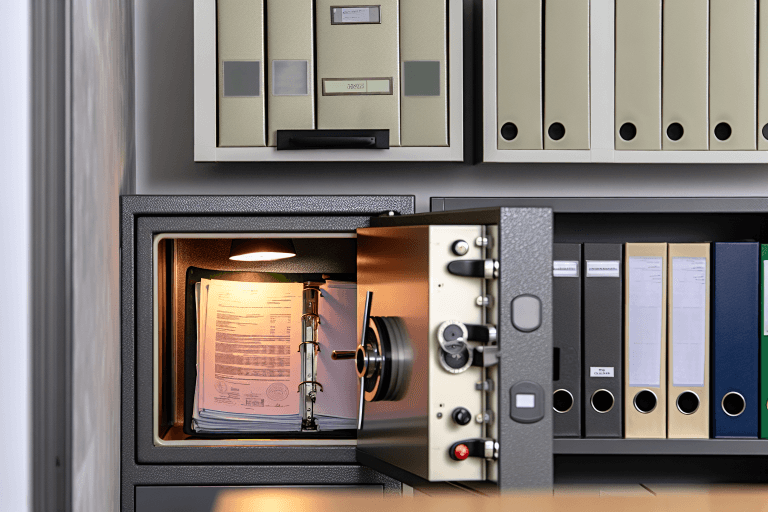
How to Keep Important Documents Safe at Home
Need to protect your critical documents at home? Learn how to keep important documents safe at home with these practical storage and organizational tips.
Our guide covers secure filing, fire and water-resistant options and digital defenses, equipping you to guard against theft, disasters, and digital breaches efficiently.
Key Takeaways
Secure essential documents, such as identification, legal papers, and sensitive photos, to prevent identity theft and ensure they are available for financial and legal transactions.
Develop a comprehensive home filing system with color-coded labeling and regular file purging to manage important paperwork effectively and maintain document relevance.
Enhance the physical and digital security of documents with fire-resistant and water-resistant safes, encryption technologies, and cloud storage solutions while ensuring quick accessibility and disaster preparedness.
Identifying Your Essential Documents
Ever thought about what documents are considered essential? They range from:
Personal identification documents such as driver’s licenses, birth certificates, and passports
Legal documents such as marriage certificates, divorce, and child custody papers
Personal items such as sentimental photos and letters
Practical items like insurance policy details
Much like keeping money safe at home, all of these documents require safekeeping.
Securing original forms of identification, such as Social Security cards, plays a pivotal role in preventing identity theft. These documents serve as official proof of identity and are often required for various financial and legal transactions.
Therefore, identifying and securing these essential documents should be your first step in document safety.
Creating a Resilient Home Filing System
Now, let’s talk about the heart of document safety - the home filing system. It’s more than just a place to stash your papers.
It’s a carefully planned strategy for managing your documents, ensuring they’re easily accessible when needed, and stored securely when not in use. An effective filing system uses alphabetical or chronological sorting for easy retrieval.
You should create separate files or folders for paperwork requiring immediate attention, such as bills or future tax documents.
Furthermore, designate a specific area in your home as the main hub for managing incoming paperwork like mail, receipts, and documents. This approach prevents clutter and lets you stay on top of your document management routine.
Color-Coded Labeling for Quick Access
Have you ever wasted hours searching for a specific document amidst a pile of similar-looking folders? That’s where color-coded labeling comes to the rescue. Using different colored folders for various document types or clients can enhance organization and quick retrieval.
Moreover, clear labeling of folders or trays ensures quick identification of the category and corresponding action required.
With this approach, navigating your filing system becomes a breeze.
Regularly Updating and Purging Files
An effective filing system involves not only storing documents but also ensuring their relevance. Regular reviews and updates are necessary for vital documents like insurance policies, wills, and financial records.
It is also recommended to securely purge old records following IRS guidelines, which recommend keeping tax documents for at least three to seven years depending on the situation. This way, your filing system remains current, manageable, and clutter-free.
Fortifying Physical Document Safety
Although developing a robust filing system is indispensable, you should not overlook the physical safety of your documents.
To safeguard important documents from theft, natural disasters, and other emergencies, consider using robust physical storage options such as fire-resistant safes, safety deposit boxes, and lockable filing cabinets.
It is important to store documents in areas with a constant temperature. Additionally, these areas should be free from the risk of flooding, extreme heat, and pests.
Choosing the Right Home Safe for Your Needs
Selecting a safe that suits your needs is a significant stride towards document safety. Fire ratings are an essential factor to consider as paper should not be exposed to temperatures above 350°F.
Also, consider the lock options - combination, key, biometric, or digital keypad - based on your personal security preferences and usability.
Ensure the safe has enough storage capacity and a size that accommodates files and folders for organizational purposes.
Strategic Placement of Safes in the Home
The location of a safe within your home significantly impacts the safety of your documents. Here are some tips for where to place your safe:
Consider placing the safe in less obvious locations, such as a child’s bedroom or pantry, to enhance security.
Safes should be securely anchored to a suitable surface with anchor bolts, either a floor or wall, to prevent the unit from being moved and deter theft.
Conceal the safe with furniture or decorations to make it less obvious.
While protecting the safe from intruders, make sure it remains readily accessible to authorized users during emergencies.
Digital Document Defense
In our technologically advanced era, the defense of digital documents holds as much importance as the safety of physical documents. Consider converting your physical documents into digital formats using tools like Adobe Scan or mobile applications to create electronic backups.
These digital copies can be stored as digital files on flash drives or cloud storage, ensuring quick access when needed.
However, storing documents digitally also brings about the challenge of securing them. It’s important to use encryption technologies and robust password protection to prevent unauthorized access and data theft.
This means not only securing your online-stored documents but also protecting the devices on which they are stored.
Utilizing Cloud Storage Wisely
When it comes to cloud storage, choosing wisely is key. Opt for providers, like Google Drive, Dropbox, or Microsoft OneDrive, that offer encryption and password protection to ensure the safety of sensitive personal documents.
When necessary, use signed URLs to securely share cloud storage objects, and stick to universally supported file formats like PDFs for document storage.
Password Protection and Management
Remembering multiple complex passwords can be a real struggle. That’s where password managers come in handy.
Tools like Passwarden, 1Password, LastPass, and Google Chrome’s password manager are essential for managing multiple complex passwords, securely storing them, and reducing the risk of weak or easily guessable passwords.
Encryption for Enhanced Security
Encryption, the process of transforming readable data into an unreadable format, is a powerful tool for digital document safety.
Personal documents can be encrypted using built-in tools on most modern operating systems, or with third-party encryption software providing additional features and levels of security.
Regularly update encryption software and maintain backups of encryption keys in secure locations to ensure the safety of encrypted files over time.
Disaster-Proofing Your Document Storage
Being prepared for all eventualities, including disasters, is a crucial aspect of document safety.
Fire-resistant bags, for instance, provide a portable solution for document safety. While they don’t offer the same level of security as fire-resistant safes, they can offer emergency protection for documents.
For optimal flood protection, safes should be installed above ground level, preferably on a base anchored to the house structure.
Additionally, consider having an emergency “go-bag” with copies of critical documents that can be taken at a moment’s notice.
Waterproof Containers and Bags
Water-resistant safes and containers can protect your documents from flood damage. Some water-resistant safes even undergo submersion tests to confirm their ability to withstand flood conditions.
Off-Site Storage Considerations
While having a robust document storage system at home is important, off-site storage options like safety deposit boxes at banks or private facilities should also be considered.
However, it’s important to be aware of access limitations and insurance requirements as contents in a deposit box are not FDIC insured.
Maintaining Privacy and Preventing Identity Theft
Maintaining privacy and preventing identity theft are fundamental to document safety. Implementing a ‘shred-all’ policy where all documents, such as ATM receipts, bank statements, and medical records, are regularly shredded can prevent human error in determining sensitive information.
Furthermore, to protect yourself from identity theft, it is important to:
Monitor your financial statements from your bank or credit union and medical records for unrecognizable transactions or services
Attest any discrepancies or unexpected changes
Regularly check your credit reports for accuracy and signs of fraud using official channels like AnnualCreditReport.com.
Keeping Your Important Papers Accessible
In addition to keeping your documents safe, maintaining their accessibility is equally significant. Organizing documents with a structured system, maintaining a list of their locations, and having an emergency go-bag for quick access can help ensure that you can access your important papers when you need them.
Informing family members and a trusted friend, relative, or lawyer about the location and organization of essential documents can enable them to access them in an emergency.
Regular discussions with family members about the whereabouts and contents of important documents, and communicating any updates, can further enhance document accessibility.
Organizing for a Moment's Notice
In an emergency, every second counts. Having a system that allows for quick access to important documents at a moment’s notice can be a lifesaver.
A three-part file container with “Do Now,” “Do Later,” and “Pending” sections can help distinguish between urgent and non-urgent documents.
Accessibility for Family Members
Important documents should not only be accessible to you but also to your family members. Making sure that a responsible family member is familiar with the ‘Just To Be Safe’ file and understands its contents and importance can ensure that your family is prepared in case of an emergency.
Keep Your Important Documents Organized and Secure
To wrap up, it’s clear that document safety is a multifaceted endeavor. From identifying essential documents to creating a resilient home filing system, fortifying physical document safety in a home safe to mastering digital document defense, maintaining privacy and preventing identity theft to integrating technology into document safety, preparedness is key.
Remember, it’s not just about storing documents but about organizing, securing, and making them accessible when needed.
Implementing the strategies discussed in this guide can help you ensure the safety of your important documents and give you peace of mind.
Frequently Asked Questions
How do you store sensitive documents at home?
Sensitive documents such as birth certificates, passports, and wills should be stored at home in a fire-resistant home safe, located out of plain sight and bolted to the floor or wall. For digital documents, have the files encrypted and stored on external hard drives and uploaded to secure cloud storage services.
What documents should be kept in a home safe?
You should keep important documents such as passports, birth certificates, property deeds, wills, and insurance policies in a home safe. These documents are difficult or impossible to replace if they are lost or destroyed.
What are considered essential documents?
Essential documents include identification documents like driver's licenses and passports, legal papers such as marriage and divorce certificates, and insurance policies. It's important to keep these documents safe and secure.
What is a resilient home filing system?
A resilient home filing system is a carefully planned strategy for managing your documents, ensuring they're easily accessible when needed, and stored securely when not in use. It helps you stay organized and find important documents quickly.






